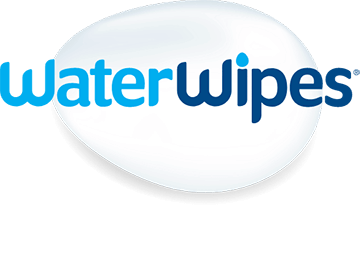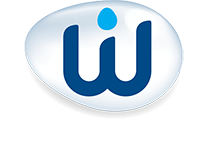When considering the use of water for the cleaning of infants, parents can sometimes be confused about the differences between tap, boiled, bottled and sterile water. In addition, research has identified that hospital care teams can have concerns relating to the purity of hospital tap water and the risk of colonizing infants with waterborne organisms.2
This article discusses different water sources and the quality of each in addition to explaining why the water contained in WaterWipes is purer than cooled, boiled water.
Raw water:
Raw water is water found in the environment that has not been treated. It may contain dissolved salts and minerals, microbes, pollutants and insoluble materials like sand and stones. Water is treated to remove any harmful components before being fed into the public supply.
Contaminants that may be in untreated water include microorganisms such as viruses and bacteria; inorganic contaminants such as salts and metals; organic chemicals from industrial processes; pesticides and herbicides.3
Dissolved minerals may affect the suitability of water for a range of purposes. The most familiar of these is likely to be the presence of calcium and magnesium,4 which have an impact on the cleaning action of soap and can form hard sulphate and soft carbonate deposits in appliances such as washing machines, boilers and other household appliances.5
Hard water may be more suitable than soft water for human consumption, as it tastes better and can help individuals to get their recommended intake of essential minerals such as magnesium and calcium.4,6 Softening on the other hand decreases nutrition (soft water typically has higher sodium content, and lower concentrations of calcium and magnesium) but can improve cleaning effectiveness.7
The impact of water hardness on skin health:
When considering the impact of water hardness on skin, research has shown that living in a hard water area can be associated with atopic dermatitis because hard water contains a high mineral content.4 Exposure to hard water has also been suggested to aggravate eczema, as it strips away the skin’s natural oils.4
In fact, a study by Nottingham University in 1998 found eczema is more common in primary school children living in hard water areas than in those who live in areas where the water is soft.8
Tap water
The quality of tap water varies from country to country. While in countries like France, Germany, Ireland and England tap water is widely considered safe to drink, in other countries this is not the case. However, tap water that is considered safe to drink can still contain chemicals such as lead,9 copper, chlorine,10 fluoride,11 zinc and nickel.
When used on the skin, some sources suggest that it might have a drying effect12 as it imposes an alkaline environment,11,13 which has the potential to upset the acid mantle. Furthermore, tap water does not remove oil-soluble material properly.11,14,15 Some of these effects may be related to water hardness, the mineral content of tap water.13
Boiled water
Boiling water is one of the most effective ways to eliminate impurities. Although it removes microbes, it cannot remove chemical toxins or impurities. When water is boiled, it is not possible to remove all of the contaminants.16 However, unless the water is very badly polluted already, boiling it is usually more than enough to make it drinkable for adult humans.15
Cooled boiled water is typically used as an effective way to clean infants’ skin. Parents can use cooled boiled water and cotton wool in the first few weeks of life while their baby’s skin develops.
Bottled water
Use of bottled water based on the assumption of purity can be misguided,17 as bottled water is not usually sterile and can contain sodium or sulphate.18
The Environmental Working Group tested 10 best-selling brands of bottled water for 170 contaminants and found different mixtures of 38 contaminants, including bacteria, fertiliser and industrial chemicals at levels similar to those allowed in tap water.19
Sterilized water
Sterile water for medical purposes is not the same thing as water that has been sterilized through boiling. Sterile water for medical purposes has undergone a very different treatment that leaves it pure and free from all contaminants.20 Guidelines in some hospitals suggest that sterile water, not tap water, should be used for baby cleansing and that sterile water should be used when washing all babies in neonatal care.21
Ultrapure water
Ultrapure water (or high-purity water) is water that has been purified to highly stringent specifications. Ultrapure water is a term that means the water is treated to the highest levels of purity for all contaminant types.22
WaterWipes water is ultrapure due to our seven-step purification process
The water used within WaterWipes is what makes the product unique.
Firstly, WaterWipes owns and manages a private groundwater source, which is recharged by the plentiful Irish rainfall coming from the moist Atlantic weather systems.
WaterWipes are manufactured under clean room conditions using a unique purifying technology. The water passes through a seven-step purification process that uses a series of filters to remove impurities, soften and purify the water. This process makes the water significantly purer than cooled boiled water.
This purifying technology produces a unique product that effectively cleanses the skin, without the need for several additional cleansing ingredients.
Many wipe products on the market contain a number of ingredients. These may include preservatives to maintain the integrity of the product. There may be one or more surfactant ingredients to remove dirt from the skin, plus emollients for feel and shine. Some but not all wipes will have a fragrance and therefore associated allergens. When you have several ingredients present there is usually the need for emulsifying agents that will allow the ingredients to mix evenly together. A buffer is often required to maintain the pH and sometimes a thickening agent to ensure the solution is the right viscosity.
Recent research has shown that nearly half (47%) of midwives and nurses agree that there is never a good time to use products containing unnecessary chemicals on a baby’s skin.23
Research has also shown that 97% believe parents should be considering what ingredients/products come into contact with a baby’s skin, and 97% of midwives and nurses that are aware of the purity credentials of WaterWipes would recommend them.21

